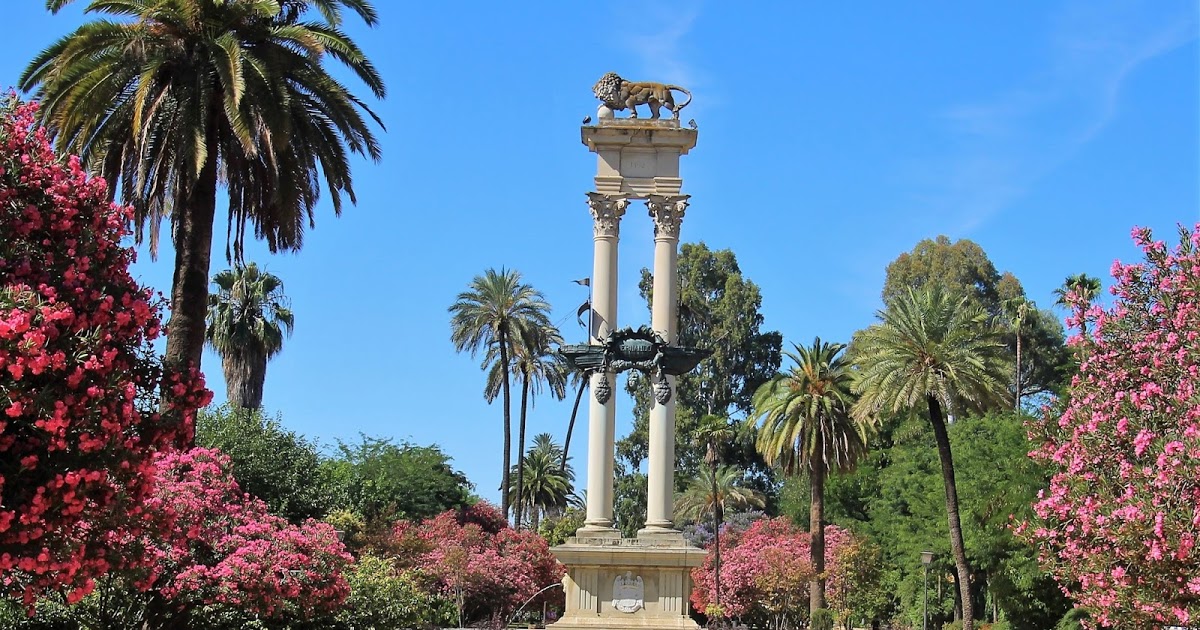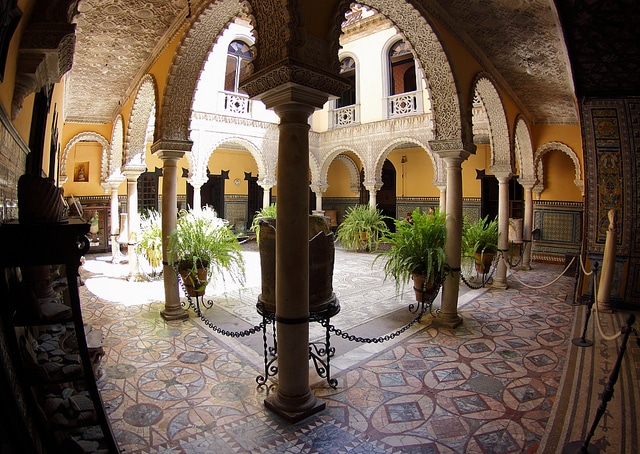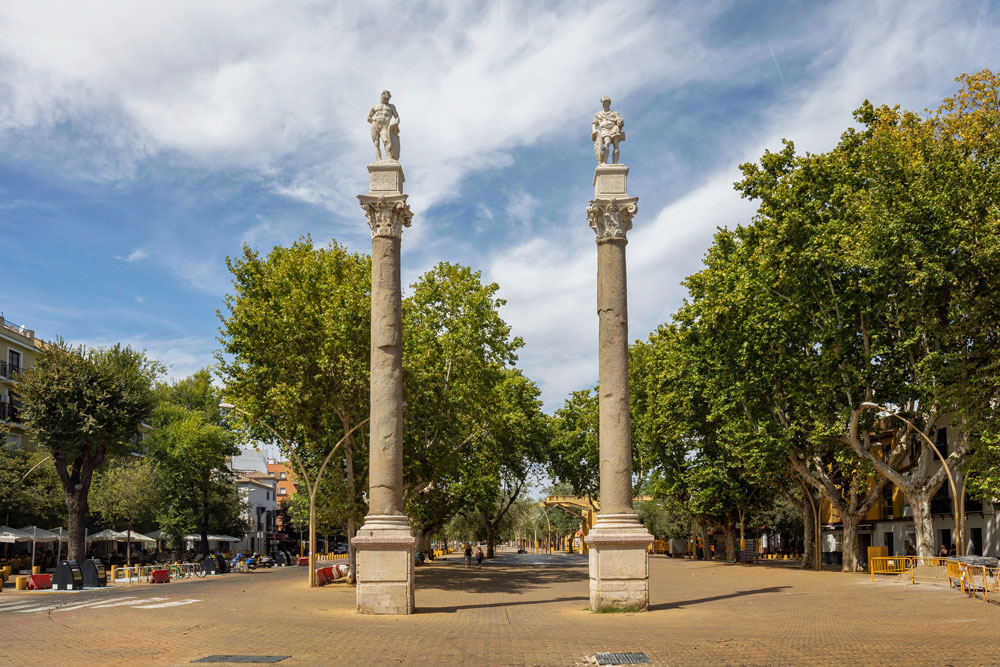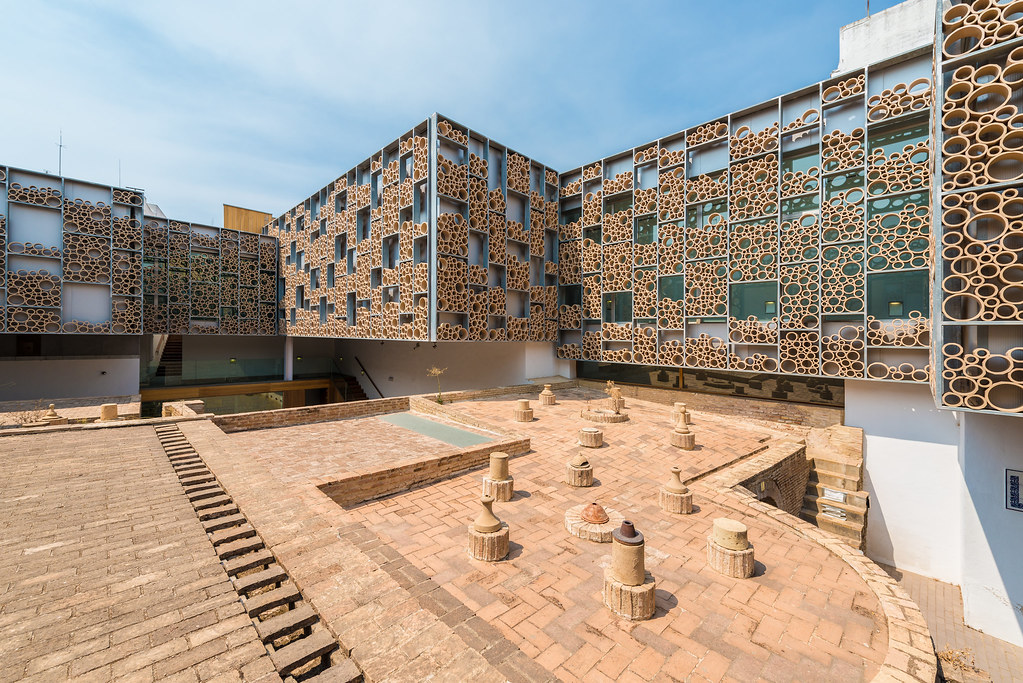Discover Seville 5 days
Located in southern Spain and the capital of Andalusia, Sevilla is, undoubtedly, the cultural center of the Iberian country, with a historical richness exciting. With a Mediterranean climate it is able to bewitch all who visit, swimming in deep-rooted traditions like the sun, the frills, and tree, Beer, the Spanish guitar or the smell of orange blossoms; and the Guadalquivir, which crosses the city presents us with the opportunity to have wonderful bridges charming and magical sunsets.
- Avenida de la Constitución
- Cathedral and Giralda in Seville
Address: Avda. of the Constitution, 41004 Sevilla
Schedule: Monday to Sunday 8.00 a 14.00 h, and of 16.00 a 19.00 h. It is recommended to go with early entry.
Phone: 902 099 692 - Reales Alcázares
Address: Patio de Banderas, 41004 Sevilla
Schedule:
01/10 – 31/03: Monday to Sunday, and holidays 9.30 a 17.00 h
01/04 – 30/09: Monday to Sunday, and holidays 9.30 a 19.00 h
Phone: 954 502 324 - General Archive of the Indies
Address: Avda. of the Constitution, 41004 Sevilla
Schedule: Monday to Saturday 9.30 a 17.00 h, and Sunday 10.00 a 14.00 h
Phone: 954 500 528 - Barrio de Santa Cruz
- Alley water
Address: starts at Plaza Patio de Banderas 3, 41004 Sevilla
Schedule: We recommend book guided tours of Barrio de Santa Cruz in advance to reserve a place. * - Hospital Los Venerables
Address: Plaza de los Venerables, 8
Schedule: Monday to Sunday 10.00 a 20.00 h.
Phone: 954 562 696 - Diego Velázquez Center
Address: Plaza de los Venerables, 8
Schedule: Monday to Sunday 10.00 a 20.00 h.
Phone: 954 562 696 - Interpretation Center of the Jewish Quarter
Address: Street Ximénez de Enciso 22
Schedule: Monday to Sunday 11.00 a 19.00 h.
Phone: 635 719 796 - Casa de Salinas
Address: Mateos Gago, 39
Schedule: Monday through Friday 10.00 a 18.00 h.
Phone: 954 21 95 39 - Murillo Gardens
Address: Of. Menendez Pelayo of S / N
Schedule: Monday to Sunday 7.00 a 24.00 h.
Phone: 955 471 232 - Church Santa Maria La Blanca
Address: C / Santa Maria La Blanca, 5
Schedule: Monday to Saturday 10:00 h – 13:00 and h 18:00 h – 20:30 h. No visit during Mass, to 11:00 h and the 19:30 h.*
* Mass Sundays and holidays: 10:00 h, 13:00 h y 19:30 h.
Phone: 954 410 593 - Casa de Pilatos
Address: Plaza de Pilatos, 1
Schedule: Monday to Sunday 9.00 a 18.00 h.
Phone: 954 225 298

We start from the Avenida de la Constitución (1), considered the most important of the historic town, which also has numerous cafes to start the day with a good breakfast. From here we reach the first stop: cathedral and (We recommend get tickets in advance as they usually have enough tails). Seville Cathedral (2), It occupies the space of the old mosque, the only day that today the Patio de los Naranjos and some walls preserved. Gothic, It is the third largest in the world, and in it are historical treasures like the tomb of Christopher Columbus. From inside you access the Giralda, from which they are obtained spectacular views of the city.
Once we we left the cathedral in the Plaza de la Virgen de los Reyes, take the exit Plaza de Triomphe and the Patio de Banderas to reach Reales Alcázares (3), of which also we recommend taking early entry. It is an impressive array of palaces gardens that summarize the history of the city, a visit that takes about two hours, so we recommend the Hall of Justice and the Court of Plaster, Palace of Peter I, and finally a walk through the gardens.

Returning to the famous avenue of the Constitution, We will reach the General Archive of the Indies (4), building reminiscent of its glorious past as a gateway to trade with India. It is a style building Renaissance Herreriano seated on a podium square, with two floors and a large central courtyard square, combining red brick and stone elements.
The next stop is Barrio de Santa Cruz (5), within which is the Real Alcázar, where we recommend visiting the famous Water Alley (6), formerly known as "wall of water" circulating a street attached to the wall of the city and carried inside two tubes leading water, to finish with a stroll through the narrow streets that make up this amazing neighborhood. In this area we will find a lot of bars to take a "top" and enjoy Seville's atmosphere.

Another important point within this area, it is the Hospital de los Venerables (7) and the Diego Velázquez Center, (8) which it was founded in 1675 and it is currently the headquarters of the Focus Foundation. It has a central courtyard and church contains paintings by Valdes Leal and Lucas Valdés.
A few meters away is our next destination, he Interpretation Center of the Jewish Quarter (9), which aims to rescue the memory of the Sephardic people of Seville, to learn more about the places and people of the Jewish quarter of Sevilla.
The first day continued with Casa de Salinas (10): a palatial home built in the sixteenth century under the Renaissance influence experienced Seville in a time when it was an important metropolis in the trade with America. Following the route we will go to the Jardines de Murillo, orchards gardens Alcazar de Sevilla.

Until the beginning of the twentieth century the place of Murillo Gardens (11) were orchards (Orchard Retreat) the gardens of the Alcázar of Seville. They were designed by Juan Talavera and Heredia, but nevertheless, in 1918, José Laguillo, director of the newspaper El Liberal, proposed name change, dedicating the gardens to the painter Bartolome Esteban Murillo.
Walking along the Avenida Menéndez Pelayo arrived at our next destination, the Church Santa Maria la Blanca (12), name given the same street where is, It was built on the site of an ancient Jewish synagogue. Among the many treasures that can be found inside, are the paintings of the Last Supper by Murillo and Luis de Piedad de Vargas.

A few minutes walk, passing through the Plaza de Los Zuarradores, is the Casa de Pilatos (13), former residence of the Dukes of Medinaceli and Alcalá. Among the many items that were imported for building from Genoa, highlight the cover of income, the columns and the source of the main courtyard. Azulejería contains cloths made in the sixteenth century.
- Maria Luisa Park
Address: Paseo de las Delicias s / n, 41013 Sevilla
Schedule: Monday to Sunday 8.00 a 22.00 h - Spain Square
Address: Avda. Isabella s / n, 41004 Sevilla
Schedule: no predetermined schedule * - San Telmo Palace
Address: C / Woods of the Border, 41004 Sevilla
Schedule: Monday through Friday 9.00 a 19.00 h - other closed days
Phone: 955001010 - Torre del Oro
Address: Paseo de Cristobal Colon, 41001 Sevilla
Schedule: Monday through Friday 9.30 a 18.45 h, Saturday and Sunday 10.30 a 18.45 h.
We recommend checking ticket price and book early. *
Phone: 954222419 - Naval Museum of Seville
Address: Interior Tower of Gold, Paseo de Cristobal Colon - Royal Cavalry - Plaza de Toros de Sevilla
Address: Paseo de Cristobal Colon 12, 41001 Sevilla
Schedule: See schedule and ticket prices in the provided phone. *
Phone: 954224577 - Museo Taurino
Address: Inside the Plaza de Toros - Plaza Nueva and Ayuntamiento
Address: New Square 1, 41001 Sevilla
City Hall hours: Monday to Thursday 9.00 a 14.00 and of 16.00 a 18.00 h, Friday of 9.00 a 14.00 h - other closed days
Phone: 955010010 - Church of the Savior
Address: Plaza de El Salvador, 3
Schedule: Monday to Saturday 11.00 a 17.30 h, and Sunday 15.00 a 19.00 h.
Phone: 954211679 - Museum of Fine Arts
Address: Museum Square, 9
Schedule:
Phone: - Palace of the Countess of Lebrija
Address: Calle Cuna 8
Schedule: Monday to Sunday 10.30 a 19.30 h. - Flamenco dance museum
Address: C / Manuel Rojas Marcos, 3
Schedule: Monday to Sunday 10.00 a 19.00 h.
Phone: 954340311

We begin our second day walking the Maria Luisa Park (1), one of the garden's beloved city. They were donated to the Sevillian by Maria Luisa Fernanda de Borbón in 1914. It is highly recommendable lost in its labyrinthine paths, ponds, fountains and lush vegetation.

This walk will take us to the most impressive square in Seville: Spain Square (2). It contains the names of all the provinces of Spain. It was projected for the Iberoamerican Exhibition 1929 by architect Aníbal González, and currently it holds all the gallantry and romantic halo, that have made it an absolutely unique space, where you can enjoy a boat ride or ideal positions barquillos.
We continue through Avenida El Cid, and gardens of San Telmo, to reach the San Telmo Palace (3) , which it was owned by the Tribunal of the Inquisition, seminar school of the University of Mercaderes, Colegio de la Marina, Company headquarters of the railway or the Literary University, to become what we know today as the official seat of the presidency of the Junta de Andalucía.

Walking along the Paseo de las Delicias is the next destination, La Torre del Oro (4), but before reaching, It is the perfect area to regain strength. Located on the left bank of the river Guadalquivir and height 36 meters, It was declared historical-artistic monument in 1931, and houses the Naval Museum of Seville (5).
After that, we will take the ride of Christopher Columbus to the right, to reach the Royal Cavalry, Y Plaza de Toros de Sevilla (6). It is Baroque and was built in the seventeenth century. He Museo Taurino (7) It is located inside the building that was opened in 1989. In 2008 the princes Felipe de Borbon Y Leticia Ortiz inaugurated new rooms, where they are also, paintings of the XVIII, XIX and XX, bullfighting, bullfighting costumes, bronzes, tiles and sculptures.
To get to our next stop walk through streets filled with bars emblematic for "tapas", as the street Flours, Arfe of Zaragoza, to lead New Square (8), where the City of Seville. The historic building that houses City Hall is one of the most remarkable examples of Renaissance architecture.

Up the Plaza de San Francisco, behind City Hall, we got to the next stop: the Church of the Savior (9). It is the second most important temple in the city after the Cathedral and is located in the ancient Roman Forum. The present church is the work of the seventeenth century in Baroque style and inside are two great works of art: crucified by Juan de Mesa (Christ of Love) or Christ Passion, work of Martinez Montanes, which processions during Holy Week. This church is in square with many bars to take a break and enjoy the tapas Seville.
Crossing the emblematic neighborhood of Alfalfa, and walking down the street Alfonso XII, We got to the Museum of Fine Arts (10). This is, the most important museum of Seville, and the second gallery in Spain, where a valuable collection of paintings preserved from the Baroque school, as well as other major exhibitions. For residents in the European Union, entrance is free, and Sunday a flea market usually held in the Plaza of the Museum.

We return down the street Alfonso XII, up to the Palace of the Countess of Lebrija (11), an example of Sevillian palatial home, with large mosaics of the ancient Roman town of Italica, at the time that collects archaeological remains of great value.
Our last destination of the day is one of the most characteristic places in the city: he Flamenco Dance Museum (12). It is a building of the eighteenth century and includes the origins and evolution of flamenco throughout history, as well as its categories and major artists.
- Metropol Parasol
Address: Square Encarnacion s / n, 41003 Sevilla
Schedule: Monday to Sunday 9.30 a 22.30 h.
Phone: 606635214 - Antiquarium
Address: Plaza de la Encarnación (37), 41003 Sevilla
Schedule: Tuesday to Saturday 10.00 a 20.00 h and Sunday 10.00 a 14.00 h.
Phone: 955471580 - Palacio de las Dueñas
Address: C / Duenas, 5
Schedule: Monday to Sunday 10.00 a 17.15 h.
Phone: 954 214 828 - Palace of the Marquises of Algaba
Address: Plaza Calderon de la Barca sn
Schedule: Monday through Friday 10.00 a 14.00 and h 18.00 a 21.00 h, Saturday 10.00 a 14.00 h - closed Sunday
Phone: 955 472 525 - street Fair
- Church of San Luigi dei Francesi
Address: Calle San Luis 37
Schedule: Tuesday to Sunday 10.00 a 14.00 and h 16.00 a 20.00 h - Monday closed - Convento de Santa Paula
Address: Calle Santa Paula 11
Schedule: check schedule by phone *
Phone: 954 536 330 - Rest of the walls and Arco de la Macarena
- Basilica of the Macarena
Address: street Becquer 1
Schedule: Monday to Sunday 9.00 a 14.00 and h 17.00 a 21.00 h.
Phone: 954 901 800 - Hospital of the Five Wounds - Andalusian Parliament
Address: Andalusian Parliament, 41009 Sevilla
Schedule: Monday to Sunday 8.00 a 22.00 h.
Phone: 954595929

Our route starts at the Plaza de la Encarnación, where the famous "Sevilla Mushrooms", area also known as Metropol Parasol (1). It is a curious lookout rising above the rooftops due to higher wood structure of the world. Under the foundations of this curious construction Roman and Arab remains have been integrated into the space through a small museum were discovered, he Antiquarium (2).
From here we take Calle Santa Angela de la Cruz, street where we find the convent of which receives name, it is advisable to go if you're open, up to the Palacio de las Dueñas (3), Seville was the residence of the House of Alba. His style ranges from Gothic-Mudejar to Renaissance, containing samples and details sevillanos touches in its bricks, tejas, tiling, limed and ceramics, also it has a typical Andalusian patio.

The street Fair (5) It will take us to our next destination: he Palace of the Marquises of Algaba (4). This is one of the finest examples of Moorish architecture in Seville, where the Centro de Arte Mudéjar Seville.
A few minutes walk, is the Church of San Luigi dei Francesi (6), An outstanding example of baroque architecture of the XVIII century, designed by Leonardo de Figueroa, but nevertheless, now he belongs to the Diputación de Sevilla.

Through the Church of San Marcos, we got to the next stop: he Convento de Santa Paula (7). This is a monastery monastic enclosure of nuns of the Order of St. Jerome. It was founded in the fifteenth century and has a rich artistic heritage that her sisters have dedicated themselves to caring. In addition you can buy some of their delicious handmade products, as jams, Membrillos, tocinos sky ... a pleasure for the palate.
In this area of the district of the Macarena, are the remains of the walls and the Arch (8).The walls were built during the period of Islamic occupation, and the door or Arco de la Macarena is with the wicket of oil and Córdoba door only three hits that are now preserved walls.

Walking through this area, we find the Basilica of the Macarena (9), temple of contemporary architecture, revering one of the images of Holy Week most famous in and out of our city, the Virgen de la Macarena. In the museum you can learn the history of this brotherhood and watch the fixtures and fittings used in their season of penance.
Our next and final destination of the day is the Hospital of the Five Wounds (10), Renaissance building designed by Martin de Gainza, He played an important welfare work. It is currently the headquarters of the Andalusian Parliament, so for your visit is required prior reservation.
- Alameda de Hercules
- Basilica of the Great Power
Address: Plaza de San Lorenzo 13
Schedule: Saturday through Thursday 8.00 a 13.00 and h 17.30 a 21.00 h, Friday of 7.30 a 22.00 h.
Phone: 954 915 686 - Convent of Santa Clara
Address: Grant Street s / n
Schedule: check schedule by phone *
Phone: 955 471 302 - Monastery San Clemente
Address: Reposo street 9
Schedule: Monday through Friday 10.00 a 13.00 and h 16.45 a 18 h, and Saturday 16.00 a 18.00 h.
Phone: 954378040 - Tower of the pellets (Dark tower)
Address: street Resolana 42
Schedule: Tuesday to Sunday 13.00 a 24.00, closed Monday.
Phone: 954909353 - Barrio de Triana
- Parroquia de Santa Ana
Address: Pastor Don Eugenio 1
Schedule: Sunday to Friday 10.30 a 13.30 h, and of 16.30 a 20.30 h, Saturday 20.00 a 21.30 h.
Phone: 954270885 - Mariners Chapel
Address: Calle Pureza 51
Schedule: check schedule by phone *
Phone: 955 010 010 - Basilica Cub
Address: street Castilla 182
Schedule: Monday to Saturday 10.00 a 13.30 and h 17.30 a 21.00 h, and Sunday 10.00 a 14.00 h.
Phone: 954333341 - Triana Pottery Center
Address: street Callao 16
Schedule: Tuesday to Saturday 11.00 a 18.00 h.
Phone: 955 474 293 - Castillo de San Jorge
Address: Square Altozano s / n
Schedule: Tuesday to Saturday 10.00 a 17.00 h, Sunday 10.00 a 14.30 h - Monday closed
Phone: 954 332 240 - Triana market
Address: Calle San Jorge 6
Schedule: Monday to Saturday 9.00 a 15.00 h; entertainment and dining 10.00 a 24.00 h.
Phone: 674 074 099

This route starts at the Alameda de Hercules (1), one of the areas with most city environments. It was created by the Conde de Barajas, and at its southern end there are two columns from the Roman Temple Street Marbles, which they are crowned with sculptures of Julius Caesar and Hercules, considered the founders of the city.
Across the street Santa Clara, we arrived at our next stop: the Basilica of the Great Power (2). Considered one of the most famous temples of the city by the large number of visits received and the number of devotees. Inside is the Christ of the Great Power, that procesiona the morning of Good Friday.
From here we walked to the Convent of Santa Ana(3). An ancient Almohad palace that belonged to Don Fadrique later, and then it became the convent of the Poor Clares company to 1998. Currently it has a cultural use and hosts cultural events.

In this area you can find many bars, so it's the perfect time to take a break and enjoy the atmosphere. Once responses forces, We continue along the Avenida de Torneo, until the Monastery San Clemente (4), This belongs to the Cistercian order and is the oldest monastery in the city, its foundation dating back to the second half of the thirteenth century. For your visit is required prior reservation.

The next destination is located across the street Resolana, and is the Tower of the pellets (5), also it is known as Dark Tower or factory Perdigones. Nevertheless, Dark name Torres receives for its current use, because it works as a camera obscura where you can see the city at a height of 45 meters.

After visiting the former destination, we take the bus 03 Councilman Jimenez Becerril in – Barqueta, to get off Arjona- Triana Bridge, to get to Barrio de Triana (6). This neighborhood, It is located on the west bank of the river, and offers many attractions to visit: beautiful churches like Parroquia de Santa Ana (7), built in the thirteenth century, the oldest and largest in the area; the Chapel of the Mariners (8), where the image is the Virgen Esperanza de Triana; or the Basilica of the Puppy, home of the magnificent image of the Christ of the Puppy. further, Triana, among other reasons, It is famous for its tradition of ceramics and pottery, for it and to know its history and evolution visit is recommended Triana Pottery Center (9), It located in an old pottery factory; in this center you can visit the factory as part of a permanent exhibition of ceramics made in different artistic styles.

In the Barrio de Triana, We also found the Castillo de San Jorge (11), ancient castle almohade, headquarters of the Spanish Inquisition of 1481 a 1785 and symbol of that institution in Europe, where you can see well-preserved archaeological remains of that historical period. Within it is the famous Mercado de Triana (12), where you can see the atmosphere of a typical Sevillian market, and enjoy our cuisine in its bars.
- Sevilla Torre
Address: Street Gonzalo Jimenez de Quesada 2
Schedule: check schedule by phone *
Phone: - Caixa Forum
Address: Sevilla Torre CC, Street López Pintado
Schedule: Monday to Sunday 10.00 a 20.00 h
Phone: 955 657 611 - Navigation Pavilion
Address: Path of Discovery 2
Schedule: Tuesday to Saturday 11.00 a 20.30 h, Sunday 11.00 a 15.00 h - Monday closed
Phone: 954 043 111 - Carthusian monastery
Address: Street Américo Vespucio 2
Schedule: Tuesday to Saturday 11.00 a 21.00 h, Sunday 11.00 a 15.30 h - Monday closed
Phone: 955 037 070 - Centro Andaluz de Arte Contemporaneo
Address: Street Américo Vespucio 2
Schedule: Tuesday to Saturday 11.00 a 21.00 h, Sunday 11.00 a 15.30 h - Monday closed
Phone: 955 037 070 - Aquarium Sevilla
Address: Spring Delight s / n
Schedule: Monday through Friday 10.00 a 19.00 h, Saturday and Sunday 10.00 a 20.00 h.
Phone: 955 441 541

The route will be our last day so called "Isla de la Cartuja" and starts at Sevilla Torre (1), the first skyscraper built in the city, and the highest in Andalusia, with a height of 180,5 meters and 37 floors, It was constructed by the architect Cesar Pelli. We recommend climbing to the viewpoint, to enjoy one of the most spectacular views of Seville.
From here we move a few meters to the Caixa Forum (2), Located in the same shopping center where the tower is located, It is the third most important. Has a surface of 7.500 m2 and was designed by architect Guillermo Vázquez Consuegra. It has two exhibition halls, an auditorium for 276 plazas; two multipurpose rooms, workshops, cafeteria and a bookstore-shop.

The next stop is Navigation Pavilion (3), built for the Universal Exhibition 1992. He was one of the most important, because of the importance of navigation in the history of Sevilla. This space offers the possibility for families and children, especially, They may know some stories and experiences of some sailors who crossed the ocean in search of a new life.

Within this same area, is the Carthusian monastery (4), in honor of Santa Maria de las Cuevas. Among its peculiarities, found the body of Christopher Columbus was buried in the monastery during 30 years, because its monks welcomed him and prepared for the trip. A few years later, He lost its religious character, It was sold to the English industrialist Charles Pickman who established a factory of pottery and porcelain. During the Universal Exhibition 1992 It was used as Pavilion Real, but nevertheless, now houses the Centro Andaluz de Arte Contemporaneo (5).

To finish the route, We suggest a visit to the Aquarium Sevilla (6), located at Muelle de las Delicias, a fantastic experience for both adults and younger. Dispose of 35 aquariums containing different animals of more than 400 species. It has a oceanario about two million liters of volume and a water column of about 9 meters high. To reach the aquarium from Isla de la Cartuja, You need to take the bus C2 in Américo Vespucio-Carthusian Monastery and get off at Glorieta Mariners Volunteers.
